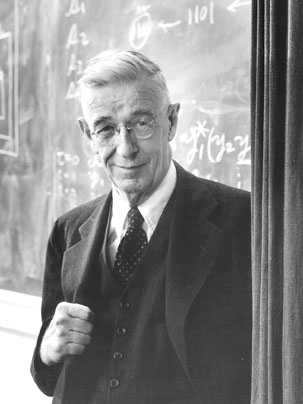"We do not take pictures with our cameras, but with our hearts and minds."
--Arnold Newman
Since the 1940s, Arnold Newman has been among the world's best-known photographers -- capturing legendary artists, poets, politicians, actors and scientists on film.
A list of his portraits, which have appeared in such magazines as Life, Fortune and the New Yorker, reads like a who's who: Igor Stravinsky, Leonard Bernstein, George Harrison, Alexander Calder, Pablo Picasso, Edward Hopper, Salvador Dali, Georgia O'Keefe, Berenice Abbott, Isaac Asimov, Eugene O'Neill, Paul Auster, Harry S. Truman, Yitzhak Rabin, Dwight Eisenhower and Marilyn Monroe.
"Arnold Newman: 20th Century Photographs," an exhibition of 40 of his portraits, is on view at the Compton Gallery through March 31. A number of leading scientists are pictured, including a few MIT figures: Vannevar Bush (1890-1974, who organized and led America's science and technology effort during World War II); Walter Rosenblith (1913-2002, pioneer in the use of computers and mathematical models in the study of the brain); and Harold "Doc" Edgerton (1903-1990, the father of electronic flash photography).
Newman also has a personal connection with MIT. His son, Eric, earned three degrees here (S.B. 1971, S.M. 1972 and Ph.D. 1977) and met his wife, Janice (Gepner), also an MIT student, here. Their daughter, Sarah, is currently a senior in earth, atmospheric and planetary sciences.
On Thursday, Feb. 16, Newman will discuss his work at 6 p.m. in Room 10-250. The talk will be followed by a reception.
Born in New York in 1918, Newman became a photographer when he couldn't afford to finish his college education. His first pictures of people were taken on the street, but he was particularly influenced by the work of the Depression-era Farm Security Administration photographers, who posed their subjects in their homes.
Newman's photographic style, referred to as "environmental portraiture," places his subjects in a physical setting related to their area of expertise, setting a context between the individual and his or her area of greatness. As a result, Newman's work provides us with an insight into the heart and being of the individual.
"I'm interested in what motivates individuals, what they do with their lives, their personalities, and how I perceive and interpret them," Newman said in an interview for PDN Legends Online. But, he said, "even if the person is not known (or already forgotten,) the photograph itself should still excite the viewer."
Newman, who continues to work, has won numerous awards and has published 13 books of photographs, including his most recent, "Arnold Newman" (Taschen Publications), which showcases more than 60 years of his work.
For more information, call x3-4444.
A version of this article appeared in MIT Tech Talk on February 15, 2006 (download PDF).






